Herring Island Park
Walking back to 1835
a self-guided tour


As the City of Melbourne grew, the native flora was replaced by exotic garden plants. This process was described in "The public Parks and Gardens", a supplement in "The Age" in 1883...
"The Yarra Park is one remove from primeval wilderness. A few clumps of foreign trees have been fenced in. For the rest, giant gum treees raise their withered arms to heaven as if mutely appealing to be removed"
The bush landscape of 1835 is being recreated on Herring Island with the planting of thousands of indigenous trees, shrubs and grasses.
Friends of Herring Island are developing a self-guided tour to show visitors some of the plants which were used by the Wurundjeri people and early European settlers. Numbered markers are to be placed by the plants listed on this page.
Information about the traditional uses of plants was sourced from "Koori Plants, Koori people", by Beth Gott and "Plants of the Merri Merri" by the Merri Creek Management Committee.
The tour will start at the boat landing opposite Como Park. In 1835 the river and Como Park (which was then a swamp) were teeming with life. The Wurundjeri people hunted waterbirds and their eggs, swamp wallaby, shellfish, eels, yabbies, tortoises and many types of fish.
We recommend you don't sample the produce as some bush foods need elaborate processing to remove toxins.
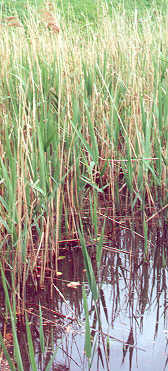 1. Common Reed (Phragmites australis) - The very young shoots were eaten by the Wurundjeri people, who also made the stems into bags and baskets. |
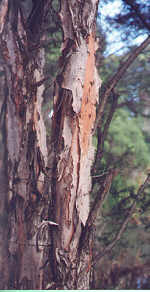 2. Swamp Paperbark (Melaleuca ericifolia) - The bark of mature trees was stripped off and used for many purposes, including rugs, bandaging and thatching. The aromatic leaves contain an oil which was used to treat coughs and colds. The stems were used for spears and digging sticks. Digging sticks were used, in gathering roots and in hunting for burrowing animals such as wombats. |
 3. River Red Gum (Eucalyptus camaldulensis) - The bark was removed in sheets and used for canoes and shelters. The gum which oozed from the trunk had various medicinal uses. |
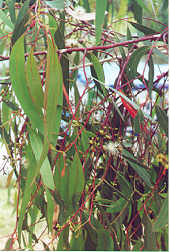 4. Manna Gum (Eucalyptus viminalis) - The wood was used to make shields, and "manna", a sugary secretion from sap sucking insects was eaten. Eucalypts are the dominant tree and a habitat for many creatures. Koalas preferred to eat the leaves of the manna gum. Possums, gliders and birds used tree hollows as nesting sites. Wurundjeri people would catch these animals by using smoke to flush them out of their holes. |
  5. Silver Wattle (Acacia dealbata) - A tree with soft grey-green feathery leaves. The gum was eaten or dissolved in water and drunk. It could also be used to make glue. The wood was used for handles on stone axes. |
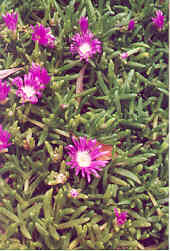 6. Rounded Noon Flower (Disphyma crassifolium) A cactus like groundcover with small edible fruit. |
 7. Warragul Greens (Tetragonia tetragonioides) - A groundcover with succulent leaves which can be used like spinach. |
 8. Native Hemp (Gynatrix pulchella) - This small tree with heart shaped leaves is no relation to the other hemp. The bark was made into string. |
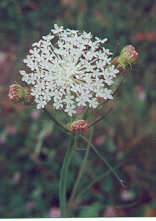 9. Wild Parsnip (Trachymene anisocarpa) - A small herb with divided leaves on red stems was used like a parsnip. |
 10. Austral Indigo (Indigofera australis) - A shrub with fern like foliage. It has purple pea flowers in spring, which were used to make dye. |
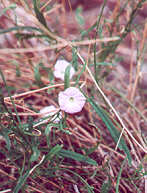 11. Blushing Bindweed (Convolvulus erubescens) - A delicate creeper with narrow arrow shaped leaves and pink flowers. The thick taproot was an important winter food, and the whole plant was used to relieve stomach pain. |
 12. Chocolate Lily (Arthropodium strictum) - A small chocolate scented purple flower, blooming in spring and summer. The bulbs were eaten raw or roasted. |
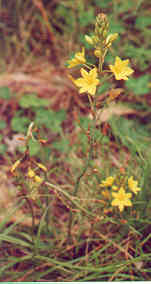 13. Bulbine Lily or Wild Onion (Bulbine bulbosa) - A yellow-flowered lily used in a similar way to the chocolate lily. |
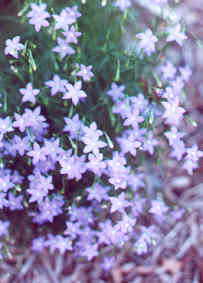 14. Tufted Bluebell (Wahlenbergia communis) - The bluebell flowers were eaten fresh. |
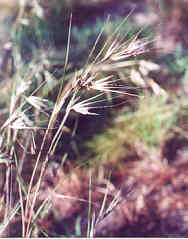 15. Kangaroo Grass (Themeda triandra) - A dense tussocky grass with large seed heads. It is a favourite food of kangaroos. The stems were made into twine for fishing nets. The seed were ground and baked for food. |
 16. Murnong or Yam Daisy (Microseris lanceolata) - A small herb with yellow flowers similar to a dandelion. The roots were eaten raw or roasted. It was a very important food for the Wurundjeri people, who used to encourage its growth by turning over the soil around it. It was growing in great abundance at the time of the European settlement but has since become rare. Edward M Curr describes Murnong as it grew in the 1840s in his memoir, "Recollections of squatting in Victoria". "At Colbinabbin, (near Echuca), yams were so abundant, and so easily procured, that one might have collected in an hour, with a pointed stick, as many as would have served a family for the day. The wheels of our drays used to turn them up by the bushel as it went over the loose ground. Indeed, several thousand sheep, which I had at Colbinabbin, not only learnt to root up these vegetables with their noses, but they for the most part lived on them for the first year, after which the root began gradually to get scarce." |
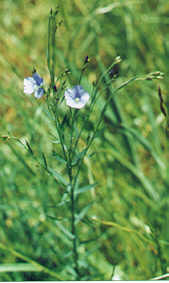 17. Native Flax (Linum marginale) - Pale blue flowers borne on long upright stems which were used to make twine for fishing nets. The seeds were also eaten. |
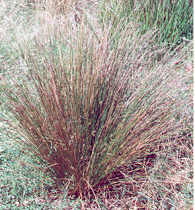 18. Common Spike Rush (Eleocharis acuta) - A local version of the Chinese water chestnut. The tubers were dug up and eaten in winter. The damp soil in this area has been planted with moisture loving species which were found in swamps and flood plains. |
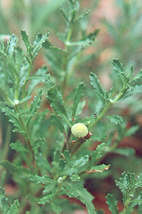 19. Old Man Weed or Sneezewood (Centipeda cunninghamii) - A small herb with tiny green globular flowers. It was used for chest complaints and as a general tonic. |
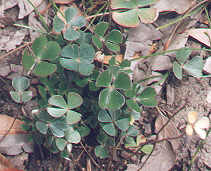 20. Nardoo (Marsilea drummondii) - looks like a four-leafed clover, but is actually a fern. The spore cases can be ground and baked into a sort of bread. The explorers, Burke & Wills tried to survive on Nardoo after all their supplies had run out. It probably did them more harm than good, because they weren't aware of the elaborate process which was needed to remove toxins from the plant. |
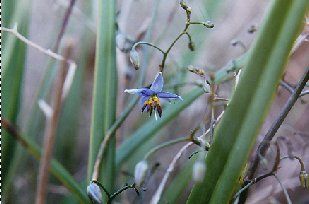 21. Black Anther Flax Lily (Dianella revoluta) - Long strap like leaves were used to make baskets and cord, and the purple berries were eaten and used for dye. |
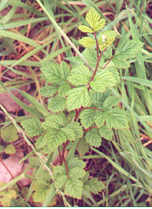 22. Native Raspberry (Rubus parvifolius) - A thorny bramble related to the European raspberry, and with similar fruit. |
 23. Woolly Tea Tree (Leptospermum lanigerum) - The stems were used for kangaroo spears. European settlers used the grey/green leaves as a substitute for tea. |
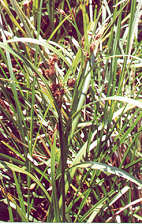 24. Marsh Club rush (Bolboschoenus medianus) - Tubers are sweet-tasting and were eaten raw or roasted. |
 25. River Mint (Mentha australis) - Was used to treat coughs, colds, stomach cramps, and as a food flavouring. |
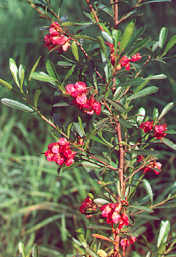 26. Wedge-leaf Hop Bush (Dodonaea viscosa) - Papery red seed capsules were used by European settlers as "hops" in beer making. Wurundjeri people chewed the leaves to relieve tooth-ache, and bound them on their skin to treat stingray wounds. |
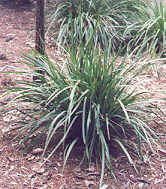 27. Spiny Headed Mat Rush (Lomandra longifolia) - The main plant used by the Wurundjeri people for making mats and baskets. |
  28. Austral Tobacco (Nicotania suaveolens) - Leafy herb related to commercial tobacco. Leaves have been chewed as a substitute for commercial tobacco. |
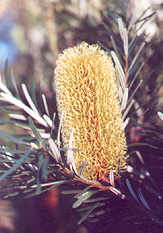 29. Silver Banksia (Banksia marginata) - A tall open shrub. The undersides of the leaves are silver-coloured. The brushy yellow flowers were soaked in water to make a sweet drink. In 1835 vast areas of grassland covered much of Victoria. The south of the path is planted with a wide variety of grasses, flowers and herbs to give you an idea of how these grasslands looked. Kangaroos, wallabies, emus, and snakes were some of the animals hunted on the grasslands. Controlled burns were regularly carried out which had the effect of stimulating fresh new growth which attracted grazing animals, and generally maintained an environment most suited to the needs of the Wurundjeri people. This practice has been called "fire-stick farming". After 1835 the grasslands were rapidly transformed into European style farmland, so that today their area has been reduced by 99.5% They are our most endangered ecosystem. |
 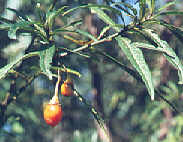 30. Large Kangaroo Apple (Solanum laciniatum) - A shrub with large glossy leaves, purple flowers and orange berries which are poisonous when unripe. Distantly related to tomatoes. |
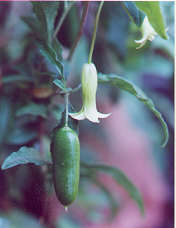 31. Common Apple Berry (Billardiera scandens) - A light climber with green berries which taste like apples.
|
 32. Maidenhair Fern (Adiantum aethiopicum) - was used to treat coughs, colds, stomach disorders and asthma.
|
 33. Native Elderberry (Sambucus gaudichaudiana) - A low growing shrub with white edible berries. Related to the European elderberry.
|
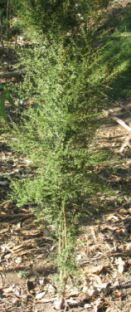 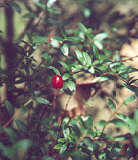 34. Prickly Currant Bush (Coprosma quadrifida) - A prickly shrub with small leaves and tiny red edible berries.
|
 35. Lightwood (Acacia implexa) - A tree with sickle-shaped leaves. The wood was used for spear throwers, clubs, shields, and the bark was used to treat rheumatism. The leaves of the Lightwood change from fern like leaves on seedlings to the sickle shaped leaves on mature trees. The fern like leaves are a throw-back to an earlier stage of evolution. The sickle shaped leaves are not really leaves but flattened stems called phyllodes, which evolved as a adaptation to a changed environment millions of years ago.
|
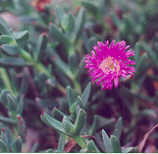 36. Pigface (Carpobrotus modestus) - A cactus-like groundcover flowering from August to January followed with purple edible fruit. Pigface once grew abundantly on the northern plains of Victoria. The introduction of hard-hooved sheep and cattle caused great destruction to this succulent plant. Edward M Curr in his memoir, "Recollections of squatting in Victoria" describes pigface growing during the 1840s. "The plain, for the thirty miles we followed it, from the Campaspe to Mount Hope, was one bed of ripe fruit, some juicy and some dried like raisins. As often, however, as I crossed the same country afterwards, 1 never again saw the pigs' faces ripe, so that I fancy that they only came to maturity in exceptional years. The plant is now nearly, if not quite, extinct in that locality. " Pigface Propogation
|
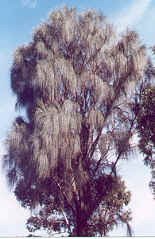 37. Drooping Sheoak (Allocasuarina verticullata)- A tree with drooping grey needle-like foliage. The wood was used to make boomerangs.
|
 38. Nodding Saltbush (Einadia wutans)- A low ground covering shrub. Sweet berries are eaten by humans and birds. Leaves are also edible if boiled to remove the excess salt. |
Downstream, the river followed a more meandering course than today, which took it through what is now the Botanic Gardens. The gardens were then a thick scrub of tea-tree, interspersed with shallow lagoons.
Further downstream, the central business district was an open woodland of gum, wattle, and sheoak with lush metre high grass underneath.
From there the river flowed past the West Melbourne swamp. This swamp covered almost two hundred hectares and supported vast flocks of waterbirds.
Close to its mouth the river was bordered by a stand of mangroves. Finally it wound its way through some low sand dunes and into the bay.
SPECIES LIST
VIEW THIS SITE WITH A MENU BAR
About Herring Island |
Getting to and What's on |
Island Map |
Artworks |
Plants |
Birds |
Sir Edmund Herring |
6 seasons |
Other Sculpture Parks
To join the Friends |
Annual Reports |
Planting Days |
Our other Friends